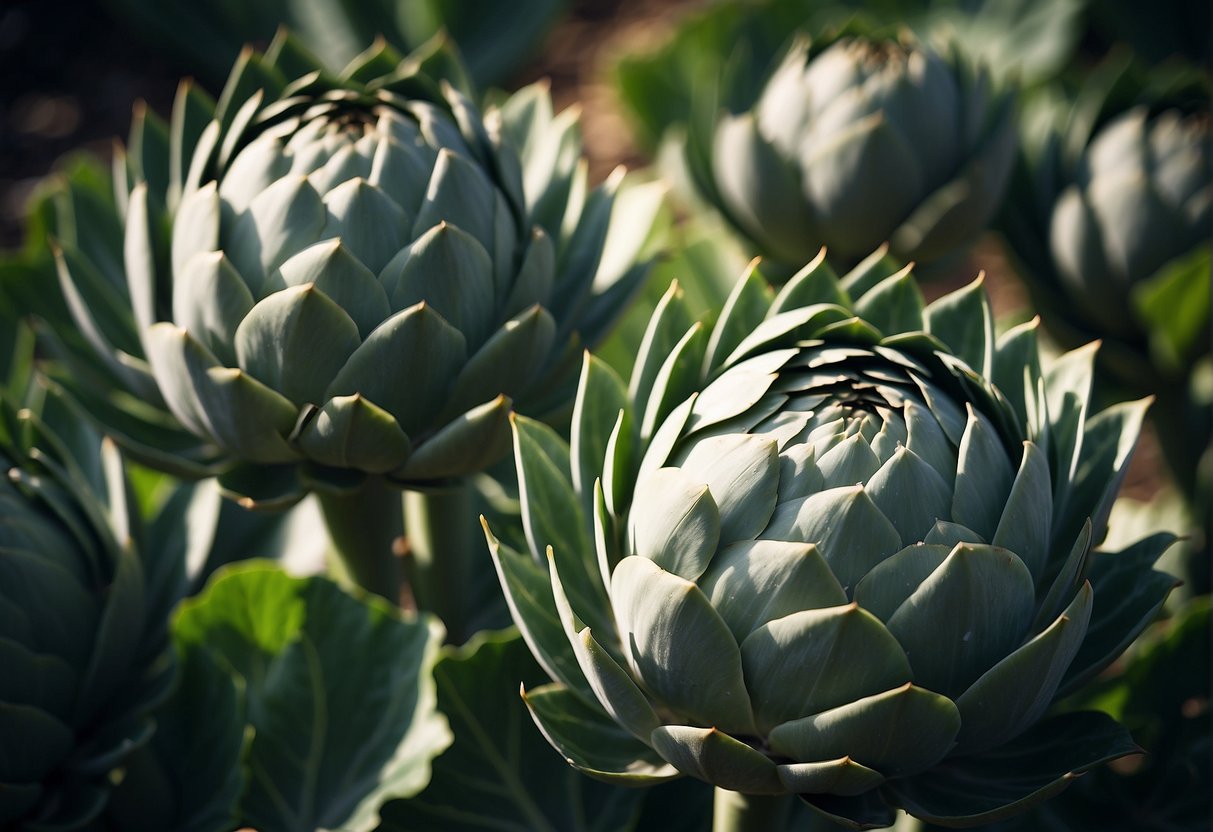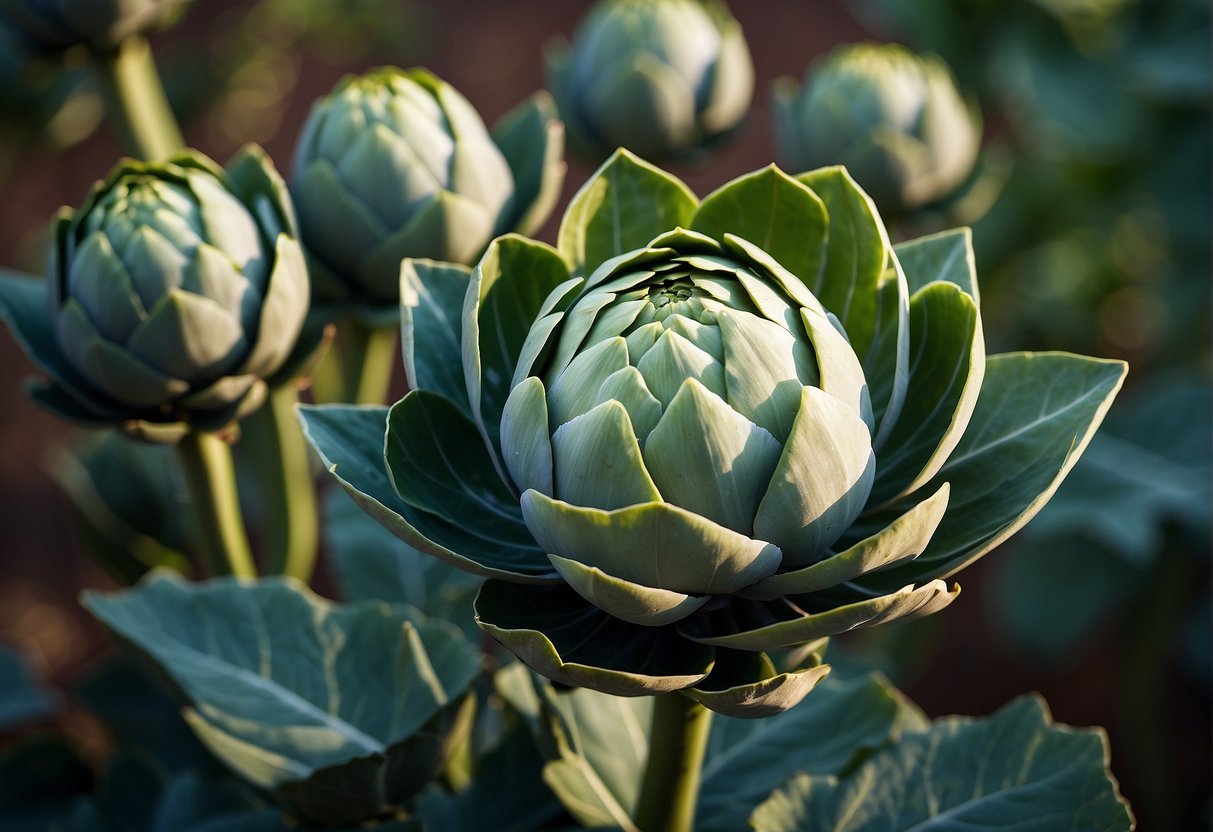How Do Artichokes Grow: A Comprehensive Guide
Artichokes are a unique vegetable that has been cultivated for centuries. They are a perennial plant that is often grown as an annual. Artichokes are grown for their edible flower buds, which are harvested before they bloom. The plant is native to the Mediterranean region, where it has been grown for food and medicinal purposes for thousands of years.

To grow artichokes, it is important to understand their growth habits. Artichokes are best grown in areas with mild winters and cool summers. They require well-drained soil and plenty of sunlight. Artichokes can be grown from seed or from transplants. When planting from seed, it is important to start them indoors in early spring and transplant them outside after the last frost. Transplants should be planted in the garden in early spring or fall.
Artichokes are a perennial plant, which means they will come back year after year if properly cared for. They can be grown as an annual in cooler climates, where they may not survive the winter. Artichokes require regular watering and fertilization to produce healthy, edible buds. With the right care, artichokes can be a rewarding addition to any garden.
Understanding Artichokes

Botanical Profile
Artichokes are a type of thistle that belong to the family Asteraceae. The scientific name for the artichoke is Cynara cardunculus. The plant is native to the Mediterranean region and has been cultivated for centuries. The artichoke plant is a perennial plant that can grow up to 6 feet tall. The leaves of the artichoke plant are large and have spiny edges. The plant produces large, edible flower buds that are harvested before they bloom.
Artichokes require a long growing season and thrive in warm, dry climates. They are typically grown as an annual crop, but can also be grown as a perennial in warmer climates. The plant prefers well-drained soil and full sun.
Varieties of Artichokes
There are several varieties of artichokes, including the Green Globe, Imperial Star, Purple, and Violetto. The Green Globe is the most common variety of artichoke and is the one most commonly found in grocery stores. The Imperial Star is a newer variety that is bred to produce more uniform, early harvests. The Purple and Violetto varieties have a more intense flavor and are often used in gourmet cooking.
The Green Globe artichoke is a large, round, green vegetable with thick, fleshy leaves. It has a mild, nutty flavor and a tender texture. The Imperial Star artichoke is smaller and more elongated than the Green Globe, and has a slightly sweeter flavor. The Purple and Violetto artichokes have a deep purple color and a slightly bitter taste.
In conclusion, artichokes are a unique and delicious vegetable that require specific growing conditions. With the right care and attention, they can be a rewarding crop for both home gardeners and commercial growers.
Cultivation Practices
Soil and Site Selection
Artichokes grow best in well-drained soil with a pH range of 6.0 to 7.5. They prefer full sun but can tolerate some shade. It is important to select a site with good air circulation to prevent diseases. Artichokes are heavy feeders and require fertile soil. The soil should be amended with compost before planting to provide nutrients.
Planting Techniques
Artichokes can be grown from seeds or vegetative cuttings. It is recommended to start seeds indoors 8-10 weeks before the last frost date. Transplant the seedlings outdoors after the danger of frost has passed. Vegetative cuttings can be taken from mature plants and planted directly in the ground. Artichokes should be planted 3-4 feet apart in rows that are 4-5 feet apart. The planting hole should be twice the size of the root ball.
Watering and Fertilization
Artichokes require regular watering, especially during the growing season. They should be watered deeply once a week, and more often during hot and dry weather. It is important not to overwater as this can lead to root rot. Artichokes are heavy feeders and require regular fertilization. A balanced fertilizer should be applied every 4-6 weeks during the growing season.
Pest and Disease Management
Artichokes are susceptible to a variety of pests and diseases, including aphids, slugs, botrytis, and weeds. It is important to monitor plants regularly and take appropriate action if pests or diseases are detected. Aphids can be controlled with insecticidal soap or neem oil. Slugs can be controlled with slug bait or by handpicking. Botrytis can be prevented by providing good air circulation and avoiding overhead watering. Weeds should be controlled by hand weeding or using a mulch.
Growth and Development
From Seed to Seedling
Artichokes are grown from seeds that take about 10-14 days to germinate. The seeds should be sown in well-draining soil with plenty of organic matter. It is recommended to start the seeds indoors in containers before transplanting them outside.
Transplanting and Spacing
After the seedlings have grown to about 3-4 inches tall, they can be transplanted to their permanent location. Artichokes need plenty of space to grow, so they should be planted at least 3 feet apart in rows that are 5-6 feet apart. The soil should be well-draining and rich in organic matter.
Seasonal Growth Cycle
Artichokes are perennials that grow best in full sun during the summer and fall months. They require at least 6 hours of sunlight per day. During the winter months, the plants go dormant and do not produce any new growth.
During the growing season, artichokes require regular watering and fertilization. They should be watered deeply once a week, and fertilized every 4-6 weeks with a balanced fertilizer. It is important to keep the soil moist but not waterlogged, as this can cause root rot.
In summary, growing artichokes from seed to harvest requires attention to detail and patience. With proper care, artichokes can produce delicious and nutritious edible buds that are a great addition to any garden.
Harvesting and Post-Harvest

When and How to Harvest
Artichokes are usually harvested when the flower buds are fully developed but before they start to open. This is when the artichoke heart is at its most tender and delicious. The bracts, which are the tough, spiky leaves that protect the flower bud, should be tightly closed and have a good, healthy green color.
To harvest artichokes, it is recommended to use a sharp knife to cut the stem of the artichoke about 1-2 inches below the base of the bud. It is important to use a sharp knife to avoid damaging the plant and to make a clean cut. After harvesting, it is important to refrigerate the artichokes as soon as possible to maintain their freshness.
Storing Artichokes
Fresh artichokes can be stored in the refrigerator for up to a week. To store them, place the artichokes in a plastic bag and store them in the crisper drawer of the refrigerator. It is important to keep the artichokes dry and away from moisture to prevent them from becoming moldy or slimy.
When storing artichokes, it is important to keep in mind that they are a perishable item and should be consumed as soon as possible for the best flavor and texture. If the artichokes are not going to be used within a week, it is recommended to blanch and freeze them for later use.
In conclusion, harvesting and post-harvesting are important steps in growing artichokes. By following the guidelines for when and how to harvest and storing the artichokes properly, growers can ensure that their crop remains fresh and delicious for as long as possible.
Frequently Asked Questions

What are the ideal growing conditions for artichokes?
Artichokes prefer a Mediterranean climate with mild winters and cool summers. They grow best in well-draining soil that is rich in organic matter. They require full sun exposure and regular watering, but they are drought-tolerant once established.
When is the best time to plant artichokes in temperate climates?
Artichokes should be planted in the early spring, after the last frost date has passed. They can also be planted in the fall in warmer climates.
What are some recommended companion plants for artichokes?
Artichokes grow well with plants that have similar soil and water requirements, such as tomatoes, peppers, and eggplants. They also benefit from the presence of herbs like thyme and rosemary, which repel harmful insects.
How large can an artichoke plant grow?
Artichoke plants can grow up to 6 feet tall and 4 feet wide. They have large, spiky leaves and produce edible flower buds that can reach up to 6 inches in diameter.
Can artichokes be grown as perennials in colder climates?
Artichokes are perennial plants in warmer climates, but they can be grown as annuals in colder climates. In colder regions, gardeners can protect the plants from freezing temperatures by mulching heavily around the base of the plant.
What is the average yield of artichokes from a single plant?
The average yield of artichokes from a single plant is 6 to 8 buds per season. However, some varieties can produce up to 20 buds per plant. The yield can also be increased by regularly fertilizing and watering the plants.
